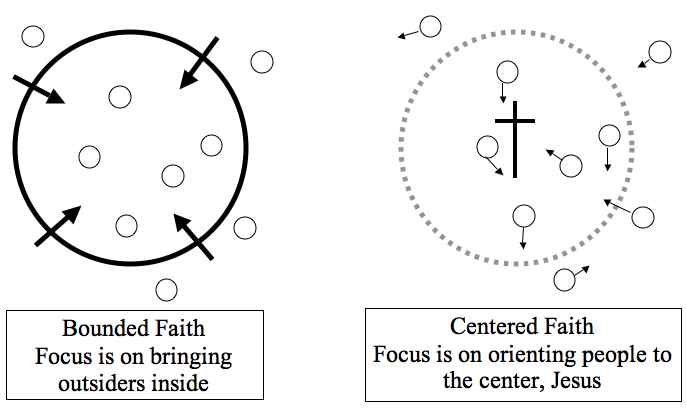An Incomplete Wedding Shower
I remember a friend relating to me the story of a mentally handicapped young woman who lived with her parents. Every time there was a wedding shower for a bride-to-be at the church, the mother would take her daughter to the event. One day, the young woman asked her mother, “When do I get my wedding shower?” not realizing that a man and an engagement were prerequisites. The mother, a kind and wise woman, instead of confusing her child with explanations, gathered some of her close friends together who brought presents and they held a “wedding shower” for the young woman. She was satisfied and never missed the “extras” that usually follow a wedding shower.
I am concerned that some of our gospel invitations are like that – a representation of reality that leaves out the most important part, the development of a relationship with Jesus Christ. The gospel message is reduced to an efficient, orderly formula: 5 colors, 4 laws, the Romans Road, a short sermon. It is a reality that people need salvation from sin, but the Savior is a stranger. It is also true that they need to humble themselves and repent, but they have not come to love Jesus. People are encouraged to accept “the gift” for its benefit to them, not because of a growing passion for the Giver.
 It is often stated that most Christians come to Christ when they are children. This statistic is given as a reason for encouraging children to pray a prayer of commitment to Christ at an early age. However, it is important to keep in mind that this is a western statistic. In other parts of the world, where there are people movements and the gospel is expanding beyond the Christian community, it is adults who are coming to Christ. Many evangelistic programs in our churches focus on children with a number of reported conversions as a result. But I suspect that these often may be like that “wedding shower” in which the relationship is not a prerequisite. Children are easily influenced and will readily accept invitations from adults they trust. Tellingly, when a child who has accepted Christ at an early age grows up, they may mention the early event of “accepting Jesus,” but will usually continue by stating, “but I didn’t really understand and I committed my life to Christ when….”
It is often stated that most Christians come to Christ when they are children. This statistic is given as a reason for encouraging children to pray a prayer of commitment to Christ at an early age. However, it is important to keep in mind that this is a western statistic. In other parts of the world, where there are people movements and the gospel is expanding beyond the Christian community, it is adults who are coming to Christ. Many evangelistic programs in our churches focus on children with a number of reported conversions as a result. But I suspect that these often may be like that “wedding shower” in which the relationship is not a prerequisite. Children are easily influenced and will readily accept invitations from adults they trust. Tellingly, when a child who has accepted Christ at an early age grows up, they may mention the early event of “accepting Jesus,” but will usually continue by stating, “but I didn’t really understand and I committed my life to Christ when….”
Disconnected from Life and Relationship
a wedding is … a metaphor for conversion
When people unfamiliar with Christian teaching hear a 5 minute gospel presentation, it may come across as a religious ritual disconnected from life. Even worse, in church if the gospel is continually reduced to a few “steps to become a whole new person,” the significance of the gospel becomes diluted, referring to an event in the past rather than the core expression of life.
Summarizing the gospel in a short presentation as a “gift” that only needs to be accepted is like inviting someone to get married before developing a relationship, as if the wedding ceremony itself is the essential act. Rather, a wedding day serves as the culmination of a growing relationship and, through covenantal vows, lifts the relationship to a higher and exclusive level. In my marriage with Karen, our wedding day is remembered fondly each year. It was an exciting and important expression of the development of our relationship. But it was the relationship that validated the wedding. It was an act within the context of an ongoing and strengthening connection between us. This perspective does not devalue our wedding vows, but puts them in the correct context: we pledged ourselves exclusively to each other because we had come to that point of commitment in our relationship.
I would see this as a metaphor for conversion. Even as a wedding is not a free gift for whoever wants it, but the natural and proper response within a developing relationship, so commitment to Christ is the response of those who have come to recognize and value the love of Christ.
Conversion within a Centered Faith
I believe that conversion is best viewed within the context of a centered faith, rather than a bounded faith.1 In a bounded perspective, the focus is on “insiders,” those who have accepted Christ, and “outsiders,” those who have not accepted Christ. The goal is have the outsiders cross the boundary of conversion in order to become insiders. Unfortunately, this can result in a tendency to reduce the gospel message to one particular response. By accentuating the boundary, the context of ongoing relationship is downplayed.
In the centered view, the focus is on Christ. The goal is to orient people, within every aspect of their lives, to the relevance of Jesus and to life in the kingdom of God. As they grow within this perspective of life centered on and oriented towards Jesus, they develop to the place of expressing exclusive commitment to him. Even as a wedding day is an important step in a relationship to establish a covenant between two people, so Jesus calls us to an exclusive relationship with him. But that commitment only occurs when there is a prior orientation towards and ongoing relationship with him. By taking a centered view, the boundary experience of total commitment to Christ finds its appropriate expression within the broader journey of moving towards him. Jesus exhorts us to count the cost (Lu 14:25-33) and it takes time to learn the implications of discipleship before making that commitment. He first called his disciples to follow him, then he took 3 years to develop a relationship with them that would bring them to that point of full commitment.
Orienting Others to Christ
baptism [is] as serious as a wedding vow
It is with this conviction that Karen and I raised our children. We did not encourage them to pray a prayer of repentance and commitment to Christ when they were young. Rather, we followed Jesus’ example and instruction in Mark 10:13-16. We constantly talked to them about Jesus and blessed them in his name so that they would learn to love him. We discussed in front of them the relevance of Christ as he related to our life situation and concerns. When they were older, we did not encourage them to be baptized. Rather, we portrayed baptism as a step as serious as a wedding vow. It is not something done lightly, it is not just an act of obedience, it is a commitment to Jesus for life. It is a covenant made when we are ready to die for Christ. As a wedding vow binds a man and a woman together for life, so baptism is a pledge that binds us exclusively to one Lord for life.
A centered view of conversion does not mean that we do not lead children to Christ. On the contrary, we must consistently orient them to him in every aspect of their lives. And then, when they do make that commitment to give their lives to Jesus, it will be within the context of an ongoing relationship.
Mark spends part of his time coaching churches in Significant Conversations. If you are interested in this method of evangelism, please contact him via the Contact Me form. If you would like to leave a comment, please use the “comment” link at the bottom of this article.
-
____________________
- 1 see Frost & Hirsch in The Shaping of Things to Come: Innovation and Mission for the 21st-Century Church (Peabody: Henderson, 2006: 47-51) for an excellent description of the implications of a bounded versus centered approach to ministry. Also Rick Brown explores the implications of a centered approach to Muslim evangelism in Muslims Who Believe the Bible in Mission Frontiers, July-August 2008: 19-23, available online.



